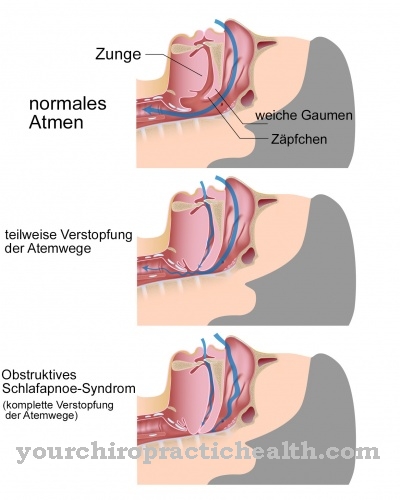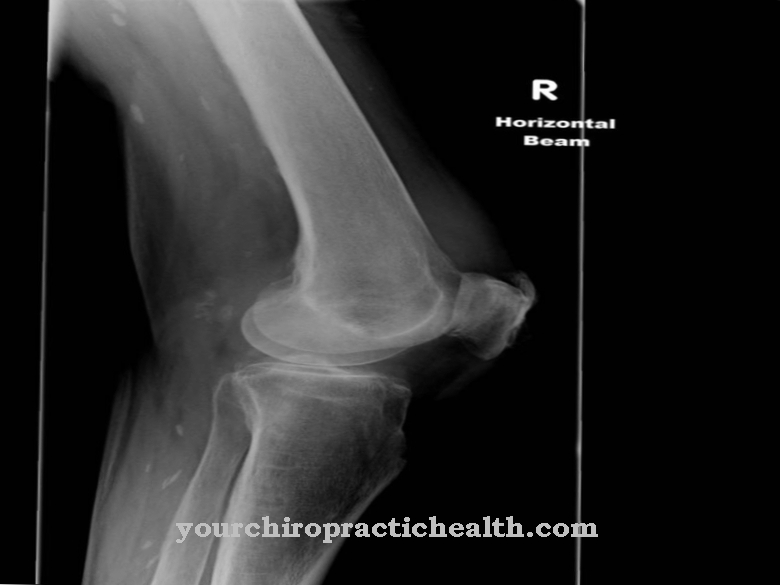Leukoplakia is a disease of the mucous membranes that is rarely found in Germany and manifests itself symptomatically in the form of atypical white changes in the affected cell tissue that cannot be wiped off. Due to the high risk of degeneration, leukoplakia should be diagnosed and treated at an early stage.
What is leukoplakia?

© Yakobchuk Olena - stock.adobe.com
As Leukoplakia (also White callused disease) are white changes in the mucous membrane that cannot be wiped off. The cells of the outermost layer of the mucous membrane keratinize and swell due to the moist tissue environment, giving them a white color.
The most common leukoplakia is found in the area of the oral mucosa, lips, palate and tongue (oral leukoplakia). Leukoplakia is divided into different stages. In a homogeneous, simple leukoplakia, the affected tissue areas are regularly discolored and have a smooth, locally well delimited surface.
In the case of wart-shaped (verrucous) leukoplakia, on the other hand, the surface is rough, while open (erosive) leukoplakia is characterized by an irregular border and red mucous areas as a result of injuries. The affected cells, especially in the verrucous and erosive form of leukoplakia, have an increased risk of degeneration and can develop into squamous cell carcinoma (malignant tumor of the skin and mucous membrane).
causes
A Leukoplakia is usually due to permanent exogenous stimuli. These stimuli can be of a mechanical or physical nature and are caused by poorly fitted dentures, braces and carious teeth.
In addition, leukoplakia can be caused by chemical noxae (pathogenic substances), in particular nicotine and alcohol. Poor dental and oral hygiene, a lack of vitamins A and B and iron also promote leukoplakia.
In addition, leukoplakia is associated with genetic diseases such as dyskeratosis congenita (Zinsser-Cole-Engman syndrome) and Darier's disease (disease with changes in the skin and mucous membranes) as well as acquired diseases such as lichen planus (flat nodules), the cutaneous form of lupus erythematosus ( Autoimmune disease).
Infectious diseases such as tertiary syphilis, HIV or fungal diseases (Candida albicans) can also cause leukoplakia.
Symptoms, ailments & signs
Leukoplakia usually do not cause clear symptoms. The disease is therefore usually discovered by the dentist during a routine examination. The doctor diagnoses leukoplakia based on the white spots on the mucous membrane that cannot be wiped off. The spots usually appear in large numbers and can be located in different places on the mouth and lips. The external characteristics provide information about the stage of the disease.
The homogeneous form shows a whitish discoloration that is sharply demarcated. The surface is usually smooth and regular, but in individual cases small bumps can be seen on the edges. The inhomogeneous shapes can be recognized by the rough, wart-like surface. In addition, pain, burning and other symptoms appear in the area of the mucous membrane.
With the erosive sub-form, red areas form in the oral cavity, which, on closer inspection, represent injuries to the mucous membrane. Erosive leukoplakias are fuzzy and painful to the touch. In the course of the disease, the spots multiply and also spread to the neighboring areas. As a result, a malignant tumor develops which, if left untreated, can cause further complaints and complications throughout the body.
Diagnosis & course
A Leukoplakia can usually already be diagnosed based on the characteristic changes in the mucous membrane. Since leukoplakia does not manifest itself in the majority of cases on the basis of any other symptoms, the disease is often discovered by chance during a check-up by the family doctor or dentist.
The diagnosis is confirmed by a sample excision (tissue removal) from the affected region with a subsequent microscopic analysis, in which the underlying disease (infection or hereditary disease) can be determined if necessary.
Leukoplakia can be treated well with adequate therapeutic measures. If left untreated, however, an advanced stage of leukoplakia has an increased risk of degeneration and can develop into squamous cell carcinoma (malignant tumor of the skin and mucous membrane tissue), which is why atypical changes in the mucous membrane area should always be examined by a doctor for possible leukoplakia.
Complications
As a rule, those affected suffer from leukoplakia from white spots, which mainly appear on the mucous membranes. Aesthetic complaints mainly occur in the face, mouth and lips. It is not uncommon for those affected to no longer feel well and suffer from inferiority complexes and a reduced self-esteem.
Furthermore, it can also cause discomfort or pain in the teeth. In children, leukoplakia can therefore lead to bullying or teasing, so that psychological complaints or depression can develop. Furthermore, leukoplakia can also cause a tumor, which can lead to a reduction in the life expectancy of the person affected. The quality of life of the patient is significantly reduced by this complaint.
Treatment for leukoplakia must start early to prevent various complications. Early treatment by the dentist is therefore necessary, especially in children. As a rule, there are no complications and the symptoms can be alleviated relatively well. The life expectancy of the patient is also not influenced or reduced with successful treatment.
When should you go to the doctor?
If changes in the mucous membrane are noticed, a doctor's visit is indicated. Whitish, conspicuously hardened areas on the lips or in the oral cavity indicate a serious disease such as leukoplakia and must therefore be examined. In the case of injuries to the mucous membrane, increasing pain and other symptoms, medical advice is required. People who wear dental prostheses or braces or who suffer from tooth decay do not always need to see a doctor for leukoplakia. These types of growths often resolve on their own once the underlying condition has been resolved.
Smokers, alcoholics and people who generally live unhealthily belong to the risk groups for malignant leukoplakia and should immediately present the symptoms described to a doctor. If the symptoms arise after a bacterial or fungal infection, you should also see your doctor. If the tumors degenerate, a doctor should be consulted immediately. In particular, wart-shaped leukoplakia must be carefully observed and, if in doubt, clarified medically. If the changes in the mucous membrane recur, the doctor must be informed.The same applies if side effects such as numb spots or pain in the area of the mucous membranes set in some time after recovery. The right doctor is the dentist, dermatologist or internist.
Treatment & Therapy
The therapy one Leukoplakia primarily targets the underlying causes. For example, badly fitting dentures should be adjusted accordingly by the dentist or carious teeth should be treated. Any infectious diseases that may cause leukoplakia must also be treated.
Leukoplakia often heals on its own within a few weeks after the causative factors have been eliminated. If this is not the case, the areas of the mucous membrane affected by leukoplakia are usually surgically removed as part of a minimally invasive procedure. The surgical techniques used here are electrocaustic ablation and a cryosurgical procedure.
Within an electrocaustic ablation, the affected tissue areas are precisely heated and destroyed with the help of a small needle, loop or ball attached to the tip of a device that is operated with low current. Although pain can occur postoperatively and must be treated accordingly, the wound caused by the procedure heals well within one to three weeks. In addition, the tissue areas affected by leukoplakia can be destroyed by local icing during a cryosurgical procedure (physical-destructive method, cryonecrosis) by cooling them to below -40 ° C with liquid nitrogen.
Outlook & forecast
The prognosis of leukoplakia depends on the cause. If the dentures are not well adapted, a corresponding correction can in many cases achieve freedom from symptoms. Diseased teeth must also be treated and, if necessary, removed. Without an improvement in the conditions in the area of the mouth, no relief from the symptoms can be achieved. Medication can be administered to support this, but the cause must be clarified in order to achieve permanent freedom from symptoms.
The consumption of pollutants must be completely avoided to improve the prognosis. In addition, oral hygiene must be optimized and adapted to the needs of the human organism. Otherwise, the prognosis will worsen. If the patient has a chronic viral disease, the prognosis worsens. In the case of an infectious disease, long-term therapy is usually necessary to alleviate the symptoms, but has no healing option.
If the cause of the symptoms can be traced back to a fungal disease, recovery can often be achieved. This depends on the disease triggers and the general state of health of the person concerned. The worse the body's immune system, the more difficult it is to treat fungi. If there is an autoimmune disease, the prognosis is also poor. In these patients, treatment is also aimed at alleviating the symptoms.
prevention
One Leukoplakia can be prevented by avoiding the triggering factors. Risk factors for leukoplakia include nicotine and alcohol consumption, inadequate oral hygiene, and poorly fitted dentures and braces. Since the disease has a comparatively high recurrence rate (relapse rate), those already affected by leukoplakia should have regular follow-up examinations carried out.
Aftercare
Follow-up care for leukoplakia primarily includes preventive measures, especially in view of the high relapse rate. In addition to careful and increased oral hygiene, this also includes regular visits to a dentist. A healthy lifestyle is also recommended, which is accompanied by a balanced diet and largely avoiding alcohol and nicotine consumption. Those affected are well advised to pay a little more attention to dental care in general; if necessary, the attending physician can give appropriate tips and advice to alleviate the suffering.
You can do that yourself
With leukoplakia, people can take various measures to support medical treatment. In general, the cause of the symptoms must first be determined.
If the leukoplakia is based on caries, the carious teeth must be extracted. This is a routine procedure, after which those affected are not allowed to eat solid food for a few hours or days. In addition to dental treatment, dental hygiene must be improved to reduce the risk of further discomfort. If the leukoplakia has been triggered by chemical agents such as nicotine or alcohol, the lifestyle must be changed. The triggering substances must be strictly avoided. In most cases, those affected have to start therapy or turn to a self-help group.
It is easier to treat a causal vitamin or iron deficiency. In this case, it is enough to change the diet and supply the body with the necessary substances. If the disease is caused by a serious infectious disease such as HIV, syphilis, or a fungal disease, the most important measure is to have it diagnosed and treated immediately. The patient can best support recovery by following the doctor's instructions and informing them of any unusual symptoms.
























.jpg)



